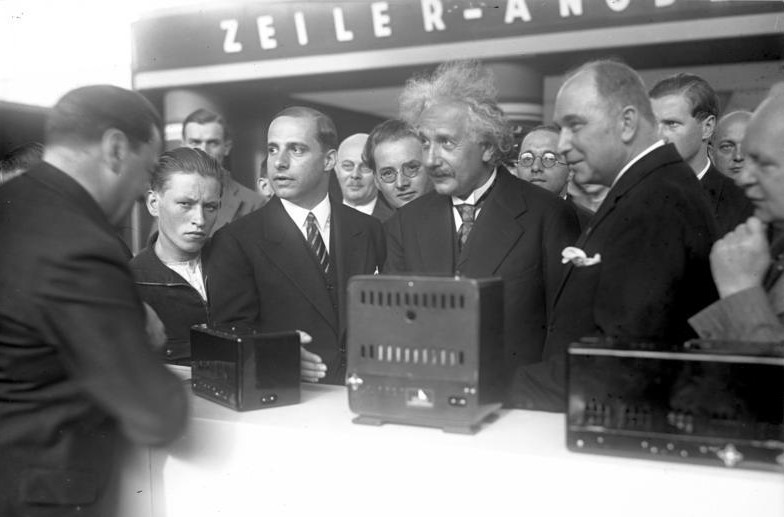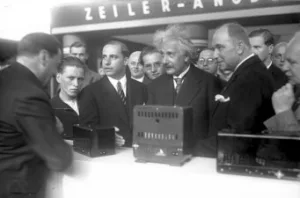On September 3, the first day of the hybrid IFA 2020 Conference in Berlin, I had a telephone interview with Marek Maciejewski, TCL Product Development Director for Europe. Maciejewski revealed that TCL might show a quantum-dot (QDOLED) TV made with inkjet printing (IJP) at IFA 2021, and that prototypes are available now. TCL is not the only company that will introduce QDOLED TVs within the next year but, to my knowledge, is the only one to have announced it publicly. That TCL will use IJP came as a surprise to me.

(we reported on it in June, Ken! JOLED Concludes Capital and Business Alliance with TCL CSOT & TCL to Sell IJP QDOLED TVs This Year! – Editor)
 The IFA originated in 1924 as the Internationale Funkausstellung Berlin (International Radio Exhibition Berlin) and claims to be the world’s oldest electronics exhibition. In 1930 Albert Einstein opened the show. (Photo: German Federal Archive)
The IFA originated in 1924 as the Internationale Funkausstellung Berlin (International Radio Exhibition Berlin) and claims to be the world’s oldest electronics exhibition. In 1930 Albert Einstein opened the show. (Photo: German Federal Archive)
Maciejewski said that JOLED will be one of TCL’s panel suppliers, and that there will be more than one. Of course, when we think of QDOLED panels we think of Samsung Display Company (SDC). Samsung has been using evaporation to put down its three layers of unpatterned blue OLED. I will guess — and it is a guess — that TCL will be using IJP to put down an unpatterned blue layer. Samsung has been using IJP to fabricate its quantum-dot color converter, so it could presumably use the technology for the blue layer given sufficient development time. But TCL did not identify its supplier(s), other than JOLED.
TCL miniLED TVs are available now in multiple series. As you might expect, the more affordable the series, the smaller the number of miniLEDs. A high-end set shown at CES 2020 had 2000 nits with 5184 dimming zones and 20,000 miniLEDs (more or less) mounted on glass with TCL’s Vidrian process. TCL uses an oxide backplane, which “provides many options for integration on glass.” MiniLED will appear in more of TCL’s sets in the future, Maciejewski said. MiniLED cost will continue to come down as fabrication on glass replaces fabrication on printed circuit boards , and the fabrication on glass is increasingly automated.
I asked if TCL was pursuing dual cell. Maciejewski said that TCL discussed that internally and decided the power consumption is too high for the European market.
We briefly discussed the TV product line TCL was showing at IFA. Maciejewski said that TCL intends to “democratize” television, by supplying advanced technology at an accessible price.
High on Maciejewski’s list was TCL’s AiPQ AI audiovisual AI processor that uses machine learning. The AI approach first identifies what kind of content is presented (e.g., green landscapes, night scenes, animation or rapid motion) and then optimizes accordingly. Skin tones and backgrounds are optimized separately. Similarly, audio is analyzed for whether it is music or speech, and optimizes accordingly. As you would expect the process does upscaling, and the increased processing power enables the use of more advanced algorithms. TCL partners with Onkyo for enhanced built-in audio, and some sets incorporate Android TV. The user can control the sets by voice directly without having to use a mobile phone.
The top of the LCD line showed at IFA was a 75-inch 8K IMAX set with Vidrian miniLED backlight, available for a bit less than $10,000. (KW)
(I also spoke to Maciejewski and asked about the TCLNXT ‘low power electronic paper’ that was shown in TCL’s press event. It seems that it is just transflective LCD and he felt that although there are some buyers that really require the long life, but also acknowledged the drop in performance compared with transmissive displays. (BR)
 TCL showed this 75-inch 8K set with Vidrian miniLED on glass backlight. (Photo: TCL)
TCL showed this 75-inch 8K set with Vidrian miniLED on glass backlight. (Photo: TCL)
Note
This article was originally published with the headline “TCL to sell IJP QDOLED TVs this year”, but this was a misunderstanding, so has been corrected. (BR)

